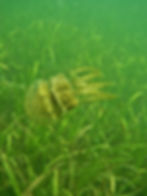The project was an attempt to value the seagrass habitat of Palk Bay in southeast India. Here are a few (much exaggerated) notes from the field.
28 May 2015: Whilst pouring over the literature, realized that this is the first time that an economic valuation of seagrass will be attempted in India. Debated the import of the projects intended outcomes, concluded that I might be famous someday.
29 May 2015: Received a ginormous amount of fisheries data. Was pretty chuffed – using file as a paper weight for the time being, to prevent it from feeling useless.
8 June 2015: Spent the majority of the morning wrapping my head around the economics of ecosystems and biodiversity with number crunching experts. Felt a tad daunted by the task at hand and lost my head around lunch time. Realised that the rest of the team was still relatively calm; put my head back on. Turns out it's hard to attribute successful fisheries to the presence of healthy seagrass exclusively, particularly when coral reefs and mangroves are also present.
9 July 2015: Spent the morning conducting surveys with artisanal fishermen. Essentially lived like bacon, it was that hot. Learned that eels of the seagrass are caught for their intestines, an ingredient in medicine, or maybe toothpaste (!)
10 June 2015: A bloody long day, filled with interviews with government officials, decision-makers and law enforcers. Spoke a great deal about morality; learnt close to nothing. Sidebar: I would not look good in prison stripes.
11 July 2015: Plunged into the waters of the Bay of Bengal for a closer look at the seagrass; activated fish speaking mode. Met a catfish, didn’t seem too keen to talk, surmised it was an introvert. Dropped in on Nemo’s brethren; such a happy duo. Ran into a sea cucumber. You think you have a basic understanding of the world, and then you encounter a sea cucumber, and nothing makes sense anymore! Was happy to see fairly healthy seagrass; not so happy to be out in jellyfish season. Post-luncheon, I tried my hand at some underwater photography; have new found respect for all underwater photographers. Contending with shifting light conditions, swaying seagrass, fish keeping up with hectic schedules, and waves hell bent on taking one out to sea, is no mean feat! Have a sneaky suspicion photography might be easier whilst diving; made a mental note to try it next time.

Jellyfish attack stance; coming in for the head-butt! © SDMRI
12 July 2015: Hoped to see a dugong (them squishy play-dough like beings, floating around seagrass, giving each other slow head bobs of recognition) in the wild. Poseidon did not oblige.
11 August 2015: Fighting trouble understanding the methodology for measuring and valuating carbon sequestration and storage potential in vegetation. Will forsake my social life for time with my pot plants.
15 October 2015: Spoke to some researchers in an attempt to source information for valuation of carbon sequestration by seagrass. Was confronted with a library of data, and overcome by a sensation of slowly sinking to the bottom of an ocean.
4 November 2015: Minor panic attack! We might not complete the project on time. Crisis is not my brand.
10 December: So much data; so little applicability value for current needs.
7 January 2016: Traveled to meet experts to validate final results. The almond biscuits at the meeting turned out to be plain biscuits; everything is falling apart! Not so. The results are valuable! Absorbed all praise with characteristic humility – after all my native brilliance can often be a gift, and a curse.
31 January 2016: Report submitted. Only took 45 minutes, two bananas consumed in stress, and a kilogram of courage to hit Send. Breathed out for the first time in a year.
2 February 2016: I know we will never be able to capture the true value of nature, how could we! But if used effectively we can use these assessments as a tool for achieving conservation, to convince communities, governments, the world to take action, to start caring!

Cuttlefish: Masters of adaptive camouflage © SDMRI

Meadows of seagrass © Nisha DSouza

Tiny fish keeping to busy schedules © Nisha DSouza

In my own underwater bubble! © SDMRI